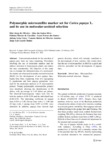Use este identificador para citar ou linkar para este item:
http://www.alice.cnptia.embrapa.br/alice/handle/doc/864169Registro completo de metadados
| Campo DC | Valor | Idioma |
|---|---|---|
| dc.contributor.author | OLIVEIRA, E. J. de | pt_BR |
| dc.contributor.author | SILVA, A. dos S. | pt_BR |
| dc.contributor.author | CARVALHO, F. M. de | pt_BR |
| dc.contributor.author | SANTOS, L. F. dos | pt_BR |
| dc.contributor.author | COSTA, J. L. | pt_BR |
| dc.contributor.author | AMORIM, V. B. de O. | pt_BR |
| dc.contributor.author | DANTAS, J. L. L. | pt_BR |
| dc.date.accessioned | 2011-04-09T16:27:27Z | - |
| dc.date.available | 2011-04-09T16:27:27Z | - |
| dc.date.created | 2010-10-14 | pt_BR |
| dc.date.issued | 2010 | pt_BR |
| dc.identifier.citation | Euphytica, Wageningen, v. 173, n. 2, p. 279-287, 2010. | pt_BR |
| dc.identifier.uri | http://www.alice.cnptia.embrapa.br/alice/handle/doc/864169 | pt_BR |
| dc.description | Conventional methods for the selection of papaya pure lines are time-consuming. Procedures involving the use of molecular markers and the indirect selection of homozygous plants can reduce this time considerably. The objective of this study was to evaluate the informativeness of a microsatellite marker set when used in marker-assisted selection (MAS) for the development of new papaya lines. Eighty-three lines originating from two segregating F3 populations and from papaya germplasm were used for the molecular analysis of 27 microsatellite primers. Twenty polymorphic microsatellite primers were identified, allowing the identification of 86 alleles, with an average of 3.18 alleles per primer. The observed heterozygosity values were low for both the markers (0.00?0.29) and the individual lines (0.00?0.35). The inbreeding coefficient (f) ranged from 0.634 to 1.00. Eleven lines with f = 1.00 and 18 lines with f varying from 0.953 to 0.961 were identified. In addition, papaya lines showed high genetic diversity, which will certainly contribute to the evelopment of new varieties. Our results show that the use of microsatellites in MAS is a quick and effective procedure for the development of papaya lines. | pt_BR |
| dc.language.iso | eng | eng |
| dc.rights | openAccess | eng |
| dc.subject | Microsatellites | pt_BR |
| dc.subject | Molecular-assisted selection | pt_BR |
| dc.subject | Papaya | pt_BR |
| dc.title | Polymorphic microsatellite marker set for Carica papaya L. and its use in molecular-assisted selection. | pt_BR |
| dc.type | Artigo de periódico | pt_BR |
| dc.date.updated | 2011-04-10T11:11:11Z | pt_BR |
| dc.subject.nalthesaurus | inbred lines | pt_BR |
| dc.description.notes | Disponivel em:<http://www.springerlink.com/content/31625u55t2134803/fulltext.pdf.> Acesso em: 14 out. 2010. | pt_BR |
| riaa.ainfo.id | 864169 | pt_BR |
| riaa.ainfo.lastupdate | 2010-12-13 | pt_BR |
| dc.identifier.doi | 10.1007/s10681-010-0150-y | pt_BR |
| dc.contributor.institution | EDER JORGE DE OLIVEIRA, CNPMF; Aline dos Santos Silva, UFRB; Fabiana Moraes de Carvalho, FAMAM; Lucas Ferraz dos Santos, UFRB; Juliana Leles Costa, UFRB; Vanusia Batista de Oliveira Amorim, UFRB; JORGE LUIZ LOYOLA DANTAS, CNPMF. | pt_BR |
| Aparece nas coleções: | Artigo em periódico indexado (CNPMF)  | |
Arquivos associados a este item:
| Arquivo | Descrição | Tamanho | Formato | |
|---|---|---|---|---|
| oliveiraEuphytica.txt.pdf | 236.16 kB | Adobe PDF |  Visualizar/Abrir |









